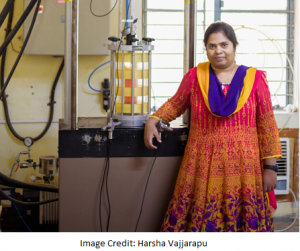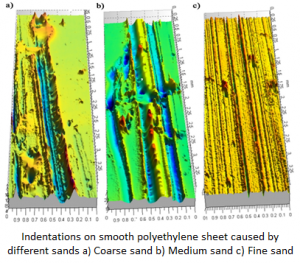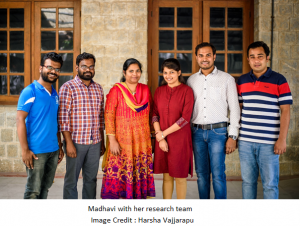SECRETS OF POLYMERIC MATERIALS BURIED IN SAND

Polymeric materials called geosynthetics are placed in sands to enhance their strength. They form an integral part of many infrastructural applications like flyovers, road over bridges, embankments and landfills. One of the key parameters for the design of these structures is the strength of the interface between sand and the polymeric materials, which mainly depends on the shape and roughness of sand particles and surface features of geosynthetics. Improving the friction at the interface is important for constructing stronger and sustainable structures.
At micro level, sand particles roll, slide over or plow through the geosynthetic surface during loading and shear, inducing changes on its surface. Madhavi and her team is working on image based techniques to relate the macro level strength of sand with geosynthetics to the micro level surface changes. As a part of this work, a new computational method is developed to quantify the shape of sand grains. A new interface shear test set-up is indigenously developed to test the strength of interfaces during shear. An experimental technique based on 3D optical interferometry is proposed for the micro-topographical analysis of geosynthetic surfaces. The macroscopic strength of sand-geosynthetic interfaces from interface shear tests is correlated to the 3D topographical surface information of sheared geosynthetics through quantification of surface indentations. Micro level sand-geosynthetic interaction mechanisms like sliding, rolling, plowing and interlocking are understood by correlating the size and shape of indents on the surface of geosynthetics to the shape of sand particles and in turn to the macro level interface friction. Effects of size and shape of sand grains on the shear induced surface changes at micro level and interface shear behaviour at macro level are demonstrated.

This research work is multi-disciplinary in nature, deriving knowledge from a wide swath of areas including granular mechanics, tribology, optical interferometry, digital filtering, image analysis, algorithms and computational geometry and finds applications in various problems related to interfaces. Madhavi is determined to take these investigations to a next level, where she could use the sand shape characterization coupled with topographical analysis of surface changes for the precise quantification of interface friction in various soil-structure interaction problems, including foundations.

Vangla, P. and Latha, G.M. (2016) “Shear behaviour of sand-geomembrane interfaces through micro-topographical analysis”. Geotextiles and Geomembranes. Vol. 44 (4), pp. 592–603.
Vangla, P. and Latha, G.M. (2017). “Surface topographical analysis of geomembranes and sands using 3D optical profilometer”. Geosynthetic International. DOI: http://dx.doi.org/10.1680/jgein.16.00023.
Other Featured research






